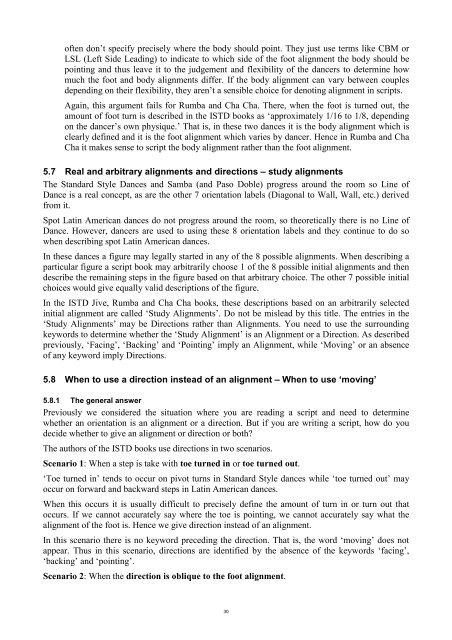Reading Ballroom Dance Scripts - Dance - Plussed.net
Reading Ballroom Dance Scripts - Dance - Plussed.net
Reading Ballroom Dance Scripts - Dance - Plussed.net
You also want an ePaper? Increase the reach of your titles
YUMPU automatically turns print PDFs into web optimized ePapers that Google loves.
often don’t specify precisely where the body should point. They just use terms like CBM or<br />
LSL (Left Side Leading) to indicate to which side of the foot alignment the body should be<br />
pointing and thus leave it to the judgement and flexibility of the dancers to determine how<br />
much the foot and body alignments differ. If the body alignment can vary between couples<br />
depending on their flexibility, they aren’t a sensible choice for denoting alignment in scripts.<br />
Again, this argument fails for Rumba and Cha Cha. There, when the foot is turned out, the<br />
amount of foot turn is described in the ISTD books as ‘approximately 1/16 to 1/8, depending<br />
on the dancer’s own physique.’ That is, in these two dances it is the body alignment which is<br />
clearly defined and it is the foot alignment which varies by dancer. Hence in Rumba and Cha<br />
Cha it makes sense to script the body alignment rather than the foot alignment.<br />
5.7 Real and arbitrary alignments and directions – study alignments<br />
The Standard Style <strong>Dance</strong>s and Samba (and Paso Doble) progress around the room so Line of<br />
<strong>Dance</strong> is a real concept, as are the other 7 orientation labels (Diagonal to Wall, Wall, etc.) derived<br />
from it.<br />
Spot Latin American dances do not progress around the room, so theoretically there is no Line of<br />
<strong>Dance</strong>. However, dancers are used to using these 8 orientation labels and they continue to do so<br />
when describing spot Latin American dances.<br />
In these dances a figure may legally started in any of the 8 possible alignments. When describing a<br />
particular figure a script book may arbitrarily choose 1 of the 8 possible initial alignments and then<br />
describe the remaining steps in the figure based on that arbitrary choice. The other 7 possible initial<br />
choices would give equally valid descriptions of the figure.<br />
In the ISTD Jive, Rumba and Cha Cha books, these descriptions based on an arbitrarily selected<br />
initial alignment are called ‘Study Alignments’. Do not be mislead by this title. The entries in the<br />
‘Study Alignments’ may be Directions rather than Alignments. You need to use the surrounding<br />
keywords to determine whether the ‘Study Alignment’ is an Alignment or a Direction. As described<br />
previously, ‘Facing’, ‘Backing’ and ‘Pointing’ imply an Alignment, while ‘Moving’ or an absence<br />
of any keyword imply Directions.<br />
5.8 When to use a direction instead of an alignment – When to use ‘moving’<br />
5.8.1 The general answer<br />
Previously we considered the situation where you are reading a script and need to determine<br />
whether an orientation is an alignment or a direction. But if you are writing a script, how do you<br />
decide whether to give an alignment or direction or both?<br />
The authors of the ISTD books use directions in two scenarios.<br />
Scenario 1: When a step is take with toe turned in or toe turned out.<br />
‘Toe turned in’ tends to occur on pivot turns in Standard Style dances while ‘toe turned out’ may<br />
occur on forward and backward steps in Latin American dances.<br />
When this occurs it is usually difficult to precisely define the amount of turn in or turn out that<br />
occurs. If we cannot accurately say where the toe is pointing, we cannot accurately say what the<br />
alignment of the foot is. Hence we give direction instead of an alignment.<br />
In this scenario there is no keyword preceding the direction. That is, the word ‘moving’ does not<br />
appear. Thus in this scenario, directions are identified by the absence of the keywords ‘facing’,<br />
‘backing’ and ‘pointing’.<br />
Scenario 2: When the direction is oblique to the foot alignment.<br />
30


